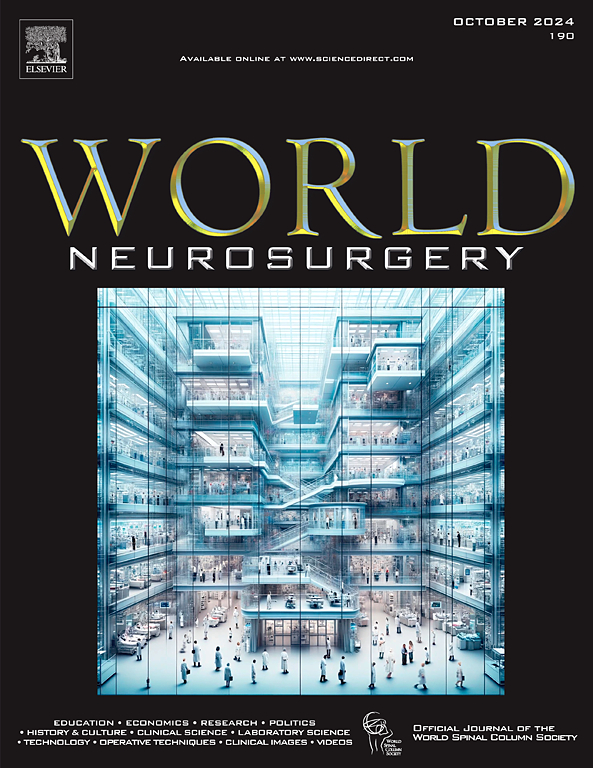Extratemporal Cholesteatoma: A Review of 9 Cases
IF 1.9
4区 医学
Q3 CLINICAL NEUROLOGY
引用次数: 0
Abstract
Background
Complete removal of cholesteatoma is critical but challenging when the matrix adheres to or destroys surrounding vital structures, such as the facial nerve, inner ear, internal carotid artery, dura mater, jugular bulb, sigmoid sinus, cavernous sinus, etc. Damage to these structures can lead to severe complications such as cerebrospinal fluid leakage, life-threatening hemorrhage, and nerve deficits.
Methods
We reviewed 9 cases of extensive cholesteatoma extending beyond the temporal bone that were treated in our department between 2010 and 2022, focusing on surgical approaches and the role of endoscopic assistance.
Results
We used various strategies to manage cholesteatoma matrices adhering to critical structures, including blunt or sharp dissection, combined dural resection with reconstruction, and targeted tumor content removal while leaving the matrix intact. Endoscopic assistance enabled us to identify and remove residual matrix remnants that were difficult to visualize with microscopy alone. Incomplete removal and gross residual lesions were associated with high recurrence rates within one year, highlighting the necessity of maximal matrix removal. Where feasible, gross total removal is preferred to minimize recurrence risk.
Conclusions
Effective management of extensive cholesteatoma requires careful balancing of complete matrix removal with protection of critical structures. Endoscopic assistance offers enhanced visualization, improving surgical outcomes by reducing residual matrix and lowering the risk of early recurrence.
颞外胆脂瘤9例分析。
导言:当基质附着或破坏周围重要结构,如面神经、内耳、颈内动脉、硬脑膜、颈球、乙状窦、海绵窦等时,完全切除胆脂瘤是至关重要的,但具有挑战性。这些结构的损伤可导致严重的并发症,如脑脊液漏、危及生命的出血和神经缺损。目的:回顾2010年至2022年在我科治疗的9例颞骨以外的广泛胆脂瘤,重点介绍手术入路和内镜辅助的作用。结果:我们使用了多种策略来处理粘附在关键结构上的胆脂瘤基质,包括钝性或尖锐的剥离,硬脑膜切除与重建相结合,以及在保持基质完整的情况下靶向肿瘤内容切除。内窥镜辅助使我们能够识别和去除残留的基质残留物,这些残留物很难单独用显微镜观察到。不完全切除和大体残余病变与一年内的高复发率相关,强调了最大基质切除的必要性。在可行的情况下,首选全切除以减少复发风险。结论:广泛胆脂瘤的有效治疗需要在完全去除基质和保护关键结构之间进行谨慎的平衡。内镜辅助提供了增强的可视化,通过减少残余基质和降低早期复发的风险来改善手术结果。
本文章由计算机程序翻译,如有差异,请以英文原文为准。
求助全文
约1分钟内获得全文
求助全文
来源期刊

World neurosurgery
CLINICAL NEUROLOGY-SURGERY
CiteScore
3.90
自引率
15.00%
发文量
1765
审稿时长
47 days
期刊介绍:
World Neurosurgery has an open access mirror journal World Neurosurgery: X, sharing the same aims and scope, editorial team, submission system and rigorous peer review.
The journal''s mission is to:
-To provide a first-class international forum and a 2-way conduit for dialogue that is relevant to neurosurgeons and providers who care for neurosurgery patients. The categories of the exchanged information include clinical and basic science, as well as global information that provide social, political, educational, economic, cultural or societal insights and knowledge that are of significance and relevance to worldwide neurosurgery patient care.
-To act as a primary intellectual catalyst for the stimulation of creativity, the creation of new knowledge, and the enhancement of quality neurosurgical care worldwide.
-To provide a forum for communication that enriches the lives of all neurosurgeons and their colleagues; and, in so doing, enriches the lives of their patients.
Topics to be addressed in World Neurosurgery include: EDUCATION, ECONOMICS, RESEARCH, POLITICS, HISTORY, CULTURE, CLINICAL SCIENCE, LABORATORY SCIENCE, TECHNOLOGY, OPERATIVE TECHNIQUES, CLINICAL IMAGES, VIDEOS
 求助内容:
求助内容: 应助结果提醒方式:
应助结果提醒方式:


